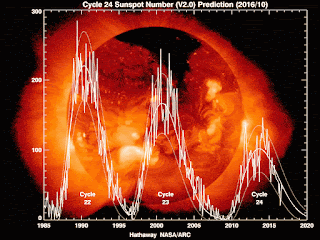As we find ourselves in the midst of Solar Cycle 25, it's time to reflect on how this cycle has shaped up compared to its predecessors over the last four decades. As an avid HF operator, I've been keenly observing the effects on band conditions, and I must say, it's been quite a ride!
First, let's recap the recent history. Solar Cycles 21 and 22, peaking in 1980 and 1989 respectively, were absolute powerhouses. Many old-timers still reminisce about the legendary DX conditions during those years. Cycle 23, maxing out in 2000, was no slouch either, offering excellent propagation well into the new millennium.
Then came Cycle 24, which peaked weakly in 2014. It was a bit of a disappointment for many hams (myself included), with reduced sunspot numbers and generally poorer HF conditions compared to what we'd grown accustomed to. This led to some gloomy predictions for Cycle 25.
But here we are in 2024, and Solar Cycle 25 has pleasantly surprised us all! While not quite reaching the lofty heights of Cycles 21 and 22, it's significantly outperforming Cycle 24 and even giving Cycle 23 a run for its money.
The current cycle kicked off in December 2019 and ramped up faster than predicted. We're seeing sunspot numbers and solar flux values that are reminiscent of the better cycles from the past 40 years. This has translated into some fantastic HF propagation, particularly on the higher bands.
What's particularly interesting about Cycle 25 is its intensity relative to recent predictions. Many solar physicists expected this cycle to be similar to or even weaker than Cycle 24. Instead, it's shaping up to be one of the stronger cycles of the past four decades, though not quite reaching the extreme peaks seen in the 1980s.
This unexpected strength has led to some fascinating scientific discussions about our understanding of the solar dynamo and the mechanisms driving these cycles. For us hams, it simply means better operating conditions than we've seen in years.
However, it's worth noting that with increased solar activity comes an increased risk of solar flares and coronal mass ejections. While these events can cause short-term radio blackouts, they also contribute to spectacular auroral displays, which can lead to some exciting VHF propagation for operators at higher latitudes.
Looking ahead, predictions suggest that this cycle may have a longer-than-average plateau at its peak, potentially providing excellent HF conditions for several years to come. This is great news for newer hams who may not have experienced a solar maximum before.
Solar Cycle 25 has breathed new life into HF operation. While it may not be breaking records set 40 years ago, it's providing a welcome boost to propagation and reminding us all why HF operation is so thrilling. If you've been neglecting your HF gear, now is the time to dust it off and get on the air. The bands are hot, and the DX is calling!







No comments:
Post a Comment